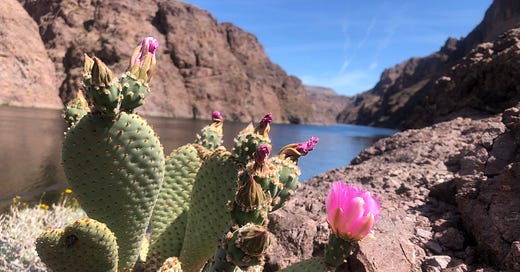In the Colorado River Basin, we talk a lot about declining reservoirs. Lake Mead and Lake Powell crashing to critically low levels. It’s what we can see — a visual for the imbalance of how we use water in the Southwest. A visual for there being more water rights than water to go around. We humans respond to visuals, what is in front of us.
But there’s a story playing out that we can’t always see, and it’s just as alarming. That story is about the loss of groundwater. Last week, researchers released a report that documented significant declines in groundwater storage in the Colorado River Basin, relied upon by 40 million people in the Southwest. Importantly, they found that losses from groundwater account for 65% of total depletion across the basin, compared with 28% for surface water. The situation is especially acute in the Lower Colorado River Basin, which includes Arizona, California and Nevada. There, groundwater depletion makes up about 71% of total losses, according to the report (see Figure 2 below).

Once again, the report shows groundwater matters more than we can see.
The report is a warning, and its conclusion is worth reading and thinking about:
“This and previous studies have clearly demonstrated that CRB [Colorado River Basin] groundwater is disappearing much faster than Colorado River streamflow and CRB surface water storage in Lakes Powell and Mead. However, CRB groundwater receives scant policy attention relative to surface water.”
…
“Groundwater sustainability underpins human and environmental security in the LCRB [Lower Colorado River Basin]. Yet climate change, limited groundwater management, and emerging pressures from the rapid growth of water and power intensive data centers and computer chip manufacturers in the region, pose major challenges to protecting groundwater for future generations.”
…
“As climate change intensifies and demands on the Colorado River continue to grow, the inclusion of groundwater in interstate CRB water discussions has become a national imperative. Historically managed at the state level, groundwater is now increasingly relied upon as surface water supplies dwindle, particularly in arid regions of the LCRB. However, the current patchwork approach to groundwater management in the U.S. has proven insufficient for long‐term sustainability. In regions like Arizona and California, where reliance on groundwater is constantly increasing, federal oversight may be necessary to ensure that groundwater resources are effectively managed in conjunction with surface water allocations. This coordinated approach will be crucial to safeguard the future water security of the entire CRB.”
“Finally, it is critical that the U.S. intensively studies the risks of disappearing groundwater on its food production, its human and environmental health, climate resilience, and its long‐term potential for economic growth. This is particularly true in the American Southwest, now more than ever, as its rapidly disappearing groundwater will come under increasingly severe stress.”
Abdelmohsen, K., Famiglietti, J. S., Ao, Y. Z., Mohajer, B., & Chandanpurkar, H. A. (2025). Declining freshwater availability in the Colorado River basin threatens sustainability of its critical groundwater supplies. Geophysical Research Letters, 52, e2025GL115593. https://doi.org/10. 1029/2025GL115593
Groundwater impacts are local, but losses have national consequences
The last few paragraphs of the paper are important. Groundwater historically falls in the jurisdiction of the states. Although many states use similar permitting systems to manage groundwater, there are big notable exceptions (ie. California) and governance varies from place to place (see Stanford’s Water in the West groundwater dashboard).
Part of this comes down to the nature of groundwater itself. Like rivers, aquifers are defined by different characteristics shaped by geology and time. In other words, they are unique and specific to place. Aquifers — and more specifically how water enters them (recharge) and leaves them (discharge) — operate differently in different places.
Seeing groundwater depletion mapped on a regional, statewide and national scale is important. It shows the sum of the parts. But assessing each part often takes place on a more localized scale, where the impacts of over-extraction are felt firsthand in the form of sinking land (subsidence), dry wells, habitat loss, the disappearance of springs and streamflow depletion. We need regional and national models, and local ones too.
Still, the sum of the parts is increasingly important. Groundwater, even at a geologic and hydrologic perspective, is not always as discrete as its governance might suggest. Underneath the surface, water can flow from one aquifer to another, a process known as interbasin flow. Groundwater feeds rivers, and streams feed groundwater aquifers.
Our laws and governance often treat aquifers and rivers as separate parts when they are actually connected. Even as the law catches up, groundwater depletion continues at an unprecedented pace, as drought, scarcity, and high demand continue to strain surface water sources. We often take more water out of aquifers than goes back in.
Clearly, in places like the Colorado River Basin (and elsewhere), the connected picture requires comprehensive attention, because the sum of each part has cascading impacts—for food systems, clean drinking water access, healthy ecosystems and much more.
How to coordinate this remains a major question for policymakers, and it’s one that the federal government started grappling with in a report last year. More on that here:
I have a lot more to write about, but that’s it for now. Will write again soon.
If you enjoy this newsletter, please consider sharing with friends or colleagues. As always, please don’t hesitate to email me with any feedback or suggestions.
Cheers,
Daniel







Cattle feed is using enormous amounts of this water. Antiquated water rights need to be updated so farmers aren't growing alfalfa and hay under the blistering summer sun. If we simply shift some of the corn ethanol production in the Midwest to cattle feed agriculture we could solve this.